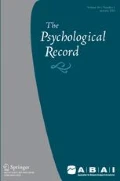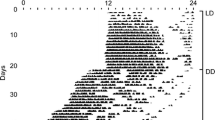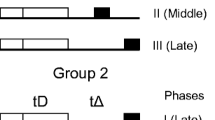Abstract
One striking aspect of the rat’s daily activity pattern is its strong nocturnal tendency. The present research tests the assumption that nocturnality in the rat serves a defensive function. If nocturnality represents a form of defense, the rat may associate light with aversive events more readily than it associates dark with aversive events. Experiment 1 examined this hypothesis in terms of the rat’s foraging behavior while living in an operant chamber. Electric footshock delivered to the grid floor near the response lever simulated the influence of predation during feeding. The results indicated that foraging behavior in the rat is sensitive to the risk of predation. Rats that had shock paired with either the light or dark phase reorganized their meal taking and reduced time spent at risk. However, the finding that the largest changes in foraging occurred when shock was delivered exclusively during the dark phase did not support the hypothesis that nocturnal feeding is a defensive behavior and was not indicative of a selective association between light and aversive events. Similar conclusions were reached when the defensive behavior freezing was used as the discriminative response in differential conditioning studies. Rate of differentiation was faster when shock was paired with a dark phase Cs, relative to pairings with a light phase Cs (Experiment 4). Rats failed to show differential freezing in a light S+ chamber and a dark S- chamber (Experiment 2), but did so with S+ and S- conditions reversed. Similar results with a light or dark chamber paired with a food Us (Experiment 3) suggested two things: first, rats that acquired the discrimination when light phase signaled shock may have relied on endogenous cues rather than light/dark per se; second, the results obtained with pairings of darkness and shock were not indicative of a selective association between darkness and aversive events.
Similar content being viewed by others
References
ALLISON, J., LARSON, D., & JENSEN, D. D. (1967). Acquired fear, brightness preference, and one-way shuttlebox performance. Psychonomie Science, 8, 269–270.
ASCHOFF, J., HOFFMANN, K., POHL, H., & WEVER, R. (1975). Re-entrainment of circadian rhythms after phase-shifts of the zeitgeber. Chronobiologia, 2, 23–78.
BARNETT, S. A. (1975). The rat. Chicago: University of Chicago Press.
BLANCHARD, R. J., & BLANCHARD, D. C. (1971). Defensive reactions in the albino rat. Learning and Motivation, 2, 351–362.
BLANCHARD, D. C., & BLANCHARD, R. J. (1972). Innate and conditioned reactions to threat in rats with amygdaloid lesions. Journal of Comparative and Physiological Psychology, 81, 281–290.
BOLLES, R. C. (1970). Species-specific defensive reactions and avoidance learning. Psychological Review, 71, 32–48.
BOLLES, R. C., & FANSELOW, M. S. (1980). A perceptual-defensive-recuperative model of fear and pain. Behavioral and Brain Sciences, 3, 291–301.
BOUTON, M. E., & BOLLES, R. C. (1980). Conditioneel fear assessed by freezing and by the suppression of three different baselines. Animal Learning and Behavior, 8, 429–434.
BRONSTEIN, P. M., & HIRSCH, S. M. (1976). The ontogeny of defensive reactions in Norway rats. Journal of Comparative and Physiological Psychology, 90, 620–628.
COLLIER, G. H. (1981). Determinants of choice. Nebraska Symposium on Motivation, 29, 69–127.
COLLIER, G. H., HIRSCH, E., & HAMLIN, P. (1972). The ecological determinants of reinforcement in the rat. Physiology and Behavior, 9, 705–716.
COLLIER, G. H., HIRSCH, E., & KANAREK, R. (1977). The operant revisited. In W. K. Honig & J. E. R. Staddon (Eds.), Handbook of operant behavior. New York: Prentice-Hall.
CURIO, E. (1976). The ethology of predation. New York: Springer-Verlag.
DAAN, S. (1981). Adaptive daily strategies in behavior. In J. Asschoff (Ed.), Biological rhythms (pp. 275–298). New York: Plenum Press.
DAVIDSON, T. L. (1987). Learning about deprivation intensity stimuli. Behavioral Neuroscience, 101, 198–208.
DICKINSON, A., & PEARCE, J. M. (1977). Inhibitory interactions between appetitive and aversive stimuli. Psychological Bulletin, 84, 690–711.
EDMUNDS, M. (1974). Defence in animals. Essex: Longmans.
EDWARDS, A. L. (1972). Experimental design in psychological research. New York: Holt, Rinehart & Winston.
FANSELOW, M. S. (1980). Conditioned and unconditioned components of post-shock freezing in rats. Pavlovian Journal of Biological Sciences, 15, 177–182.
FANSELOW, M. S. (1981). Naloxone and Pavlovian fear conditioning. Learning and Motivation, 12, 398–419.
FANSELOW, M. S. (1982). The post-shock activity burst. Animal Learning and Behavior; 10, 448–454.
FANSELOW, M. S. (1984). Opiate modulation of the active and inactive components of the postshock reaction: Parallels between naloxone pretreatment and shock intensity. Behavioral Neuroscience, 98, 269–277.
FANSELOW, M. S. (1986). Associative vs. topographical accounts of the immediate shock freezing deficit in rats: Implications for the response selection rules governing species specific defensive reactions. Learning & Motivation, 17, 16–39.
FANSELOW, M. S. (1989). The adaptive function of conditioned defensive behavior: An ecological approach to pavlovian stimulus substitution theory. In R. J. Blanchard, P. F. Brain, D. C. Blanchard, & S. Parmigiani (Eds.), Ethoexperimental Approaches to the Study of Behavior (pp. 151–166), Nato Asi Series D, Vol. 48. Boston: Kluver Academie Publishers.
FANSELOW, M. S., & BAACKES, M. P. (1982). Conditioned fear-induced opiate analgesia on the formalin test: Evidence for two aversive motivational Systems. Learning and Motivation, 13, 200–221.
FANSELOW, M. S., & BOLLES, R. C. (1979). Naloxone and shock-elicited freezing in the rat. Journal of Comparative and Physiological Psychology, 93, 736–744.
FANSELOW, M. S., & LESTER, L. S. (1988). A functional behavioristic approach to aversively motivated behavior: Predatory imminence as a determinant of the topography of defensive behavior. In R. C. Bolles & M. D. Beecher (Eds.), Evolution and learning (pp. 185–212). Hillsdale, NJ: Erlbaum.
FANSELOW, M. S., LESTER, L S., & HELMSTETTER, F. J. (1988). Changes in feeding and foraging patterns as an antipredator defensive strategy: A laboratory simulation using aversive stimulation in a closed economy. Journal of the Experimental Analysis of Behavior, 50, 361–374.
GARCIA, J., & KOELLING, R. A. (1966). Relation of cue to consequence in avoidance learning. Psychonomie Science, 4, 123–124.
GOODKIN, F. (1976). Rats learn the relationship between responding and environmental events: An expansion of the learned helplessness hypothesis. Learning and Motivation, 7, 382–393.
HEARST, E., & JENKINS, H. M. (1974). Sign-tracking: The stimuius-reinforcer relation and directed action. Austin, TX: Psychonomie Society.
HIRSCH, S. M., & BOLLES, R. C. (1980). On the ability of prey to recognize predators. Zietschrift fur Tierpsycholiogie, 54, 71–84.
JACOBS, W. J., & LOLORDO, V. M. (1977). The sensory basis of avoidance responding in the rat. Relative dominance of auditory or visual warning signals and safety signals. Learning and Motivation, 8, 448–466.
JACOBS, W. J., & LOLORDO, V. M. (1980). Constraints on Pavlovian aversive conditioning: Implications for avoidance learning in the rat. Learning and Motivation, 11, 427–455.
JENKINS, H. M. (1973). Noticing and responding in a discrimination based on a distinguishing element. Learning and Motivation, 4, 115–137.
JENSEN, G. B., COLLIER, G. H., & MEDVIN, M. B. (1983). A cost-benefit analysis of nocturnal feeding in the rat. Physiology and Behavior, 31, 555–559.
KRUUK, H. (1972). The spotted hyaena. Chicago and London: University of Chicago.
LESTER, L. S., & FANSELOW, M. S. (1985). Exposure to a cat produces opioid analgesia in rats. Behavioral Neuroscience, 99, 756–759.
LEVITSKY, D. A. (1970). Feeding patterns of rats in response to fasts and changes in environmental conditions. Physiology and Behavior, 5, 291–300.
LOLORDO, V. M. (1979). Selective associations. In A. Dickinson & R. A. Boakes (Eds.), Mechanisms of learning and motivation (pp. 367–398). Hillsdale, NJ: Erlbaum.
LOLORDO, V. M., & JACOBS, W. J. (1983). Constraints on aversive conditioning in the rat: Some theoretical accounts. In M. D. Zeiler & P. Harzem (Eds.), Advances in analysis of behavior: Vol. 3. Biological factors in learnino (pp 325–350). New York: Wiley.
MAATSCH, J. L. (1959). Learning and fixation after a single shock trial. Journal of Comparative and Physiological Psychology 52, 408–410.
MASTERSON, F. A., & CRAWFORD, M. (1982). The defense motivational System: A theory of avoidance behavior. Behavioral and Brain Sciences, 5, 661–696.
MEYER, D. R., CHO, C., & WESEMANN, A. F. (1960). On problems of conditioning discriminated lever press avoidance responses. Psychological Review, 67, 224–228.
O’nEILL, W., & BIEDERMAN, G. B. (1974). Avoidance conditioning as a function of appetitive stimulus pretraining: Response and stimulus transfer effects. Learning and Motivation, 5, 195–208.
OVERMIER, J. B., & PAYNE, R. J. (1971). Facilitation of instrumental avoidance learning by prior appetitive Pavlovian conditioning to the cue. Acta Neurobiologiae Experimentalis, 31, 341–349.
PANKSEPP, J., & KROST, K. (1975). Modification of diurnal feeding patterns by palatability. Physiology and Behavior, 15, 673–677.
PHILIPPENS, K. M. H., MAYERSBACH, H. V., & SCHEVING, L E. (1977). Effects of the scheduling of meal-feeding at different phases of the circadian system in rats. Journal of Nutrition, 107, 176–193.
RATNER, S. C. (1967). Comparative aspects of hypnosis. In J. E. Gordon (Ed.), Handbook of clinical and experimental hypnosis (pp. 550–587). New York: Macmillan.
RICHTER, C. P. (1965). Biological clocks in medicine and psychiatry. Springfield: Thomas.
RICHTER, C. P. (1967). Sleep and activity: Their relation to the 24-hour clock. In S. Kety, E. Evarts, & H. Williams (Eds.), Sleep and altered States of consciousness (pp. 8–28). Baltimore: Williams & Wilkins.
ROSENWASSER, A. M., BOULOS, Z., & TERMAN, M. (1981). Circadian organization of food intake and meal patterns in the rat. Physioiogy and Behavior, 27, 33–39.
ROVEE, K. C., KAUFMAN, L. W., & COLLIER, G. H. (1977). Components of predation defense behavior in chickens: Evidence for endogenous rhythmicity. Physioiogy and Behavior, 19, 663–671.
SATINDER, K. P. (1976). Reactions of selectively bred strains of rats to a cat. Animal Learning and Behavior, 4, 172–176.
SCAVIO, M. J., Jr. (1974). Classical-classical transfer: Effects of prior aversive conditioning upon appetitive conditioning in rabbits (Oryctolagus cuniculus). Journal of Comparative and Physiological Psychology, 86, 107–115.
SCAVIO, M. J., Jr., & GORMEZANO, I. (1980). Classical-classical transfer: Effects of prior appetitive conditioning upon aversive conditioning in rabbits. Animal Learning and Behavior, 8, 218–224.
SELIGMAN, M. E. P. (1970). On the generality of laws of learning. Psychological Review, 77, 406–418.
SHETTLEWORTH, S. J. (1983). Function and mechanism in learning. In M. D. Zeiler & P. Harzem (Eds.), Advances in analysis of behavior: Vol. 3. Biological factors in learning (pp. 1–39). New York: Wiley.
SIEGEL, P. S. (1961). Food intake in the rat in relation to the light-dark cycle. Journal of Comparative and Physiological Psychology, 54, 294–301.
SIGMUNDI, R. A., & BOLLES, R. C. (1983). CS modality, context conditioning, and freezing. Animal Learning and Behavior, 11, 205–212.
SIGMUNDI, R. A., BOUTON, M. E., & BOLLES, R. C. (1980). Conditioned freezing in the rat as a function of shock intensity and CS modality. Bulletin of the Psychonomie Society, 15, 254–256.
SPITERI, N. J. (1982). Circadian patterning of feeding, drinking and activity during diurnal food access in rats. Physioiogy and Behavior, 28, 139–147.
VAN WILLIGEN, F, EMMETT, J., COTE, D., & AYRES, J. J. B. (1987). CS modality effects in 1-trial backward & forward excitatory conditioning as assessed by conditioned suppression of licking in rats. Animal Learning & Behavior, 15, 201–211.
VILCHEZ, C. A., & ECHAVE LLANOS, J. M. (1971). Circadian rhythm in the feeding activity of Oxymycterus rutilans. Role played by light and food availability. Journal of Interdisciplinary Cycle Research, 2, 73–77.
WELKER, R. L., & WHEATLEY, K. L. (1977). Differential acquisition of conditioned suppression in rats with increased and decreased luminance levels as Cs+s. Learning and Motivation, 8, 247–262.
ZUCKER, I. (1971). Light-dark rhythms in rat eating and drinking behavior. Physioiogy and Behavior, 6, 115–126.
Author information
Authors and Affiliations
Additional information
This research was submitted in partial fulfillment of the requirements for a PhD degree at Dartmouth College by L. S. Lester. Support was provided by NIMH Grant #MH39786 to the second author.
Rights and permissions
About this article
Cite this article
Lester, L.S., Fanselow, M.S. Nocturnality as a Defensive Behavior in the Rat: An Analysis in Terms of Selective Association Between Light and Aversive Stimulation. Psychol Rec 42, 221–253 (1992). https://doi.org/10.1007/BF03399599
Published:
Issue Date:
DOI: https://doi.org/10.1007/BF03399599




